Jointness Advances, Stovepipes Reign
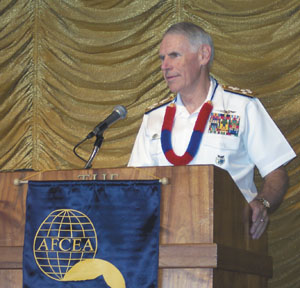 |
| Adm. William J. Fallon, USN, commander, U.S. Pacific Command, gives his perspective on the vast Asia-Pacific region at TechNet Asia Pacific in Honolulu. |
Despite the ongoing push toward information system interoperability, attaining the goal of Defense-Department-wide jointness may fall victim to the need for some stovepipe systems. While
Warfighting requirements have the services speeding new technologies, especially from the commercial sector, into the field to support ongoing operations. Branches of service and elements of unified commands are engaging in more mission-specific tasks that are unique to their units. And, more diverse countries are joining U.S.-led coalitions for a wide range of activities from counterterrorism operations to disaster relief and reconstruction.
Many of the key issues affecting joint and coalition operations were discussed by distinguished panelists and speakers at TechNet Asia Pacific, held December 5-8 in
 |
| Thomas Roberts (r) of the Defense Intelligence Agency (DIA) Regional Service Center Pacific, kicks off his panel on intelligence with panelists (l-r) Barbara Sullivan, Joint Intelligence Center Pacific; Lt. Col. Willard Squire, USA, U.S. Army Pacific; Randy Marks, INTELINK Management Office; Robert Gourley, DIA; and Lt. Col. R. Eric Duke, USA, G-2, 25th Infantry Division Light. |
Marks also reported that people are not getting their questions answered. Instead, they are getting “lots of reports.” Instead of one-stop shops, intelligence personnel have to query huge shopping malls of information, and each mall claims that it has all the information that a user needs. Marks called for three developments: personalization, which would allow the user to decide what he or she needs or wants; subscription, particularly to provide easy methods of subscribing to items of interest; and delivery of information to users on schedule with a method that produces what they need.
Producers must go back to answering questions versus generating a product, and they must make their information available for real-time delivery, Marks charged.
Panel moderator Thomas Roberts, Defense Intelligence Agency Regional Service Center (RSC) Pacific, gave a brief outline of that RSC. Then he turned the discussion over to Robert Gourley, U.S. Defense Department intelligence information systems, chief technology officer, Defense Intelligence Agency, who described how the Department of Defense Intelligence Information System (DODIIS) is providing services to the Joint Intelligence Operations Capability (JIOC) through RSCs. The JIOCs offer operational command and control (C2) of intelligence, surveillance and reconnaissance (ISR) assets. However, they must interface into the services’ Global Command and Control System (GCCS) assets, and these GCCSs must interoperate fully, Gourley said.
The
Information must be useful to be effective, and analysts are a key to that effectiveness. Having just returned from
 |
| Eugene Renzi (r), president, ManTech Defense Systems Group, and chairman of the AFCEA Board of Directors, moderates a panel on support to the warfighter. Panelists are (l-r) Col. John Cloninger, USMC, Headquarters, U.S. Marine Corps Command, Control, Communications and Computers; Col. Darryl Dean, USA, Defense Information Systems Agency (DISA)-Pacific; Col. Andy Meuller, USAF, U.S. Pacific Command; and Lt. Gen. Steven Boutelle, USA, U.S. Army G-6. |
Online magazines serve as both propagandists and carrier pigeons. More than 4,500 terrorist-related Web sites were noted in 2005, and every second al-Qaida member carried a laptop and a Kalashnikov assault rifle. Terrorist caves in the
“We will be in this war for a long time,” Gen. Boutelle warned. “This isn’t going to go away … there is no negotiation [possible].”
Gen. Boutelle described many key steps that the Army is undertaking to modernize its infostructure. It is moving converged voice, video and data onto Internet protocol (IP). The Installation Information Infrastructure Modernization Program will be replacing hardware such as cables and switches as it moves toward IP. Videoconferencing will be moving down to battalion level, as will voice over Internet protocol (VoIP), the Defense Information Systems Network (DISN), the nonsecure Internet protocol router network (NIPRNET) and the secret Internet protocol router network (SIPRNET). Army Knowledge Online (AKO) is being pushed forward around the world, so reach-back will not be an issue.
Another key advance is that military satellite communication standard theater entry platform (STEP) sites are being converted to teleport sites. These teleport sites will provide the Army with the ability to also connect through commercial satellites. Commercial technologies such as WiMAX will play major roles, although the general noted that technology is moving so fast that the Army has not been able to test it or train for it.
Col. John Cloninger, USMC, Joint Matters Spectrum Management, Science and Technology Branch U.S. Marine Corps Command, Control, Communications and Computers (C4), added that tactical satellite links are necessary for moving situational awareness information down to warfighters. Without satellite communications, the Marine Corps will need to leverage other technologies such as balloons and long-duration, high-altitude, solar-powered aircraft. The doctrine of operational maneuver from the sea is impelling the movement of the Marine air-ground task force C2 onto the Global Information Grid (GIG), he added.
The two great challenges facing the Pacific Command are knowledge creation and true open standards, according to its commander, Adm. William J. Fallon, USN. The admiral’s breakfast address began the second day of the conference. Discussing knowledge creation, he allowed that separating the wheat from the chaff is becoming tougher every day—and the need to manage this is critical.
Information plays a key role in the command’s top priority, which is the war on terrorism. Adm. Fallon shared that the command is conducting operations every day with
Stability and security in the
The admiral cited several technology areas of interest. These include behavior pattern recognition software, artificial intelligence, speech recognition and information technology systems that interoperate. Video, data and voice streams also must be interoperable without boxes. The tsunami relief effort brought up the need for interoperable methods of learning facts and acting on them, Adm. Fallon said.
“You can help us immensely in many areas,” he told the industry attendees. “[But] I’m looking for results, and they can’t be delayed by technical glitches.”
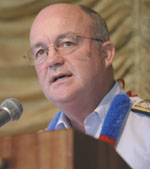 |
| Rear Adm. Charles D. Wurster, USCG, describes his service’s actions in disaster relief after Hurricane Katrina. |
One of the key characteristics that enabled the Coast Guard to respond effectively is its decentralized C2 structure. This allowed local commanders to shift resources as needed.
And resources were substantially shifted even before the hurricane hit. The admiral noted that every Coast Guard air station contributed hardware and personnel to the Katrina effort. Because Coast Guard assets are multimission, the service was able to redeploy assets to ensure their survival and the ability to respond quickly after Katrina passed.
The Coast Guard had established “solid partnerships” with federal, state and local authorities, the admiral related. As a result, the Coast Guard rescued 24,000 people and evacuated more than 9,000 from hospitals and treatment centers after Katrina. And, it had to deal with 200 grounded vessels, seven major pollution cases on top of more than 1,100 regular pollution cases.
Technology aided in this effort, he continued. Circuits were routed through multiprotocol label switching (MPLS) via a virtual private network in
Adm. Wurster offered that the Coast Guard’s Deepwater program (SIGNAL Magazine, December 2002, page 39) is in better shape than ever. Congress is providing the funding necessary to ensure the program’s viability. For the future, the free space optics project could help improve data sharing among authorities. This system would employ high-speed laser links short distances across the ocean.
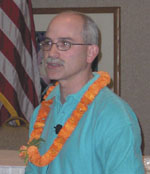 |
| Martin Gross of DISA briefs the audience on the Joint Command and Control effort. |
The Defense Department program cannot afford to replace server farms and desktop computers, Gross asserted. So, JC2 is focusing on integration and evolution of current capabilities. Any development will be that of integration approaches. The system will use the existing infrastructure.
JC2 comprises several major elements. A new service-oriented software architecture and philosophy will involve stripping out data from applications. This way, data and applications are not mutually dependent—and not necessarily Web-based. Highly collaborative design and development will leverage existing elements and emerging concepts.
A new testing process at multiple networked facilities will take a totally different approach to testing. Instead of testing systems, this approach will test from a service perspective. The goal is to achieve distributed functional and security testing, Gross explained. A new security accreditation process will focus on network-centric and small, frequent capabilities.
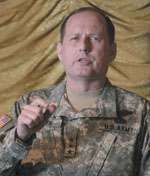 |
| Lt. Gen. John M. Brown III, USA, commanding general of U.S. Army Pacific, describes the transformation his command is undergoing. |
Accordingly, the U.S. Army Pacific is changing in ways that go beyond the ongoing military transformation. “What is happening in the Pacific proves that, not only can you transform while fighting, you should transform while fighting because it helps you now and in the future,” he told attendees at the Wednesday breakfast.
To be able to project power effectively throughout the vast region, the Army is working on fielding a warfighting headquarters that would contain all of the personnel and equipment to run a joint force land component headquarters. A version of this early entry headquarters will be established in
The general explained that all corps-, division- and brigade-level assets will be world deployable, but theater Army assets will be Pacific oriented. The U.S. Army Pacific will field a theater sustainment command, a civil affairs and civil administration command, a theater Army aviation command and a theater signal command. It also will operationalize a theater network capability.
But threats loom throughout the region.
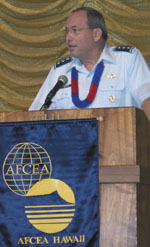 |
| Lt. Gen. David A. Deptula, USAF, vice commander, U.S. Pacific Air Forces, describes challenges facing his command. |
The heart of the new headquarters is its air and space operations center, and it helps conquer “the tyranny of distance” that defines operations over the vast Asia-Pacific region. The headquarters features 250 miles of optical fiber and includes CENTRIXS connectivity. All warfighting headquarters can share information, and its exchange can be instantaneous.
With a coalition force likely to define future operations, the command is considering stationing up to six Global Hawk unmanned aerial vehicles (UAVs) in
In November, the command conducted exercise Resultant Fury to demonstrate an attack on moving sea surface targets in bad weather. This effort featured technologies from the Defense Advanced Research Projects Agency, Gen. Deptula related, and assets were employed across the broad span of the Pacific theater. It provided a glimpse of the networked future, he concluded.
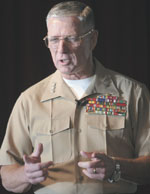 |
| Lt. Gen. John F. Goodman, USMC, commander, U.S. Marine Forces Pacific, describes the complexities of coalition operations in the information age. |
This need extends beyond the Korean theater. The war on terrorism has changed the metric of warfare. Gen. Goodman related that since World War II, the
“We must win the ideological fight, and C2 can help us,” he said.
C2 lies at the heart of winning the war on terrorism and addressing other problems ranging from regional security to stopping a potential avian flu pandemic, the general continued. For example, harnessing information can help mitigate the threat of improvised explosive devices (IEDs).
But a primary need exists to create the global partnership necessary for allied partners to govern effectively and win hearts and minds, Gen. Goodman said. This will entail trying to gain security and a stable environment that will help the disenfranchised. “We must deter war, not just fight,” he stated.
For the Pacific Fleet, the challenge is to continue to maintain a forward presence to deter or stop the enemy, said Rear Adm. John J. Donnelly, USN, the fleet’s deputy commander and chief of staff. The global war on terror is at the forefront of the fleet’s activities, but other priority disciplines include antisubmarine warfare—the region is home to more than 250 submarines—ballistic missile defense and joint force operations.
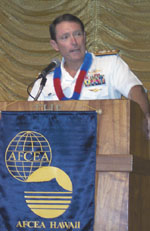 |
| Rear Adm. John J. Donnelly, USN, Pacific Fleet deputy commander and chief of staff, describes the importance of technology for the fleet’s mission. |
Adm. Donnelly stated that technologies are instrumental to success in this region. Among the fleet’s technology needs are artificial intelligence, relational databases, nonproprietary processes, signal processing for decision making, hazardous cargo tracking technologies and maritime situational awareness.
The information technology changes that are sweeping the Pacific Command center on force transformation, according to Col. Vince Valdespino, USAF, chief technology officer, U.S. Pacific Air Forces. Moderating a Wednesday panel that focused on information technology transformation in the Pacific, the colonel allowed that the military buildup now underway on Guam will feature a permanent presence of bombers, strike aircraft, refueling tankers and intelligence, surveillance and reconnaissance capabilities. The goal is to decrease the footprint of theater deployability while increasing its capability.
Speed to capability, operational availability and secure command, control, communications, computers and intelligence (C4I) are the three pillars of the Pacific Fleet C4I strategy, reported Linda Newton, the fleet’s N-6 and chief information officer. She declared that maritime domain awareness is the cornerstone of actionable intelligence, and automated information systems must get information into the network.
 |
| Col. Vince Valdespino, USAF (r), chief technology officer, U.S. Pacific Air Forces, launches a panel on the information technology transformation sweeping the Pacific region. Panelists are (l-r) Col. Thomas G. Cole, USA, 311th Signal Command; Col. Greg Edwards, USAF, Combined Forces Command, Korea; Col. Darryl Dean, USA, DISA-Pacific; and Linda Newton, U.S. Pacific Fleet. |
“We’re only as good as our last phone call,” said Col. Edric A. Kirkman,
He emphasized that an important element will be standard conditions for network access, or SCNA. A new technology will have to pass muster under its guidelines if it is to become part of the infostructure. “It won’t get on the network unless it meets SCNA,” the colonel declared.
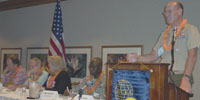 |
| Col. Kevin Jordan, USMC (r), chief of operations, J-6, U.S. Pacific Command, begins a panel on the expanding Pacific theater. Panelists are (l-r) Bob Stephenson, Space and Naval Warfare Systems Command; Col. Donald Person, USA, Pacific Island Healthcare Project; Cindy Moran, DISA; and Col. Edric A. Kirkman, USA, 516th Signal Brigade. |
Among the advances in current and future projects are conversion of the Global Command and Control System (GCCS)-K completely to CENTRIXS-K; adding common operational picture and collaboration tools to all networks; expanding the involvement with Southeast Asia nations active in the Cooperation Afloat Readiness and Training (CARAT) exercises; and deployment on U.S. Coast Guard cutters. Stephenson noted that
Stephenson noted that one of the issues to be solved is that of too many networks. The Navy needs a single multinational network, he emphasized.
But many network issues remain unresolved. Cindy Morgan, vice director for strategic planning and information, Defense Information Systems Agency, cited information assurance and security; standardized tools, processes and procedures; and sensitive but unclassified information as a few of these issues.
She called for a redesign of both the NIPRNET and the SIPRNET—changes in technology mean it is time to take a new look at those two, she declared. Army Knowledge Online is a good portal that should be adapted for use by all—there is no need to design a new one. Theater network operations centers will have virtual network management. And, the insider threat should come back to the forefront of security concerns. Saying that 70-percent solutions are acceptable, she told the audience to “adapt, buy, then create.”
 |
| Col. Bill Febuary, USMC (r), G-6, U.S. Marine Forces Pacific, discusses communications and security issues that emerged with tsunami relief with panelists (l-r) Capt. Sandra Buckles, USN, U.S. Forces Japan; Col. Vince Valdespino, USAF, U.S. Pacific Air Forces; Brian Fila, Office of the Assistant Secretary of Defense for Networks and Information Integration; Rear Adm. James B. Godwin III, USN, direct reporting program manager for NMCI; and moderator Col. Jennifer Napper, USA, J-6, U.S. Pacific Command. |
Col. Valdespino of the Pacific Air Forces returned to describe how the Air Force interoperated during tsunami relief. Collaboration with the Marine Corps went well, but some unforeseen challenges did emerge. The two services had some different technologies, but the biggest problem was nomenclature. The lexicon meant different things to each service, the colonel related.
“You can spend all the money you get, but a 20-year-old American youth can do something with it that you never expected,” declared Brian Fila, director, contingency support and migration planning, Office of the Assistant Secretary of Defense for Networks and Information Integration. Fila described how sailors had hacked into a ship’s local area network so they could network and play their X-Boxes. While the military is well equipped and trained for information technology, the rest of government had not been funded for what is expected of it in the aftermath of the tsunami and Katrina. And, leaders must plan for post-disaster stabilization and reconstruction—including an exit policy.
Panel moderator Col. Jennifer Napper,
Photography by William R. Goodwin and Robert K. Ackerman
 |
| A U.S. Navy bugler blows taps alongside the USS Missouri at a special AFCEA commemoration of the 64th anniversary of the attack on Pearl Harbor. |




Comments